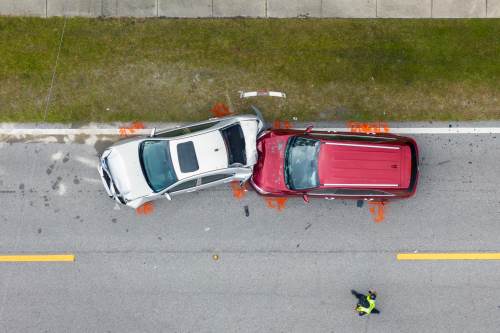- Free Consultation: (630) 527-4177 Tap Here to Call Us
How the Time of Day Influences the Likelihood of Serious Car Crashes

When you hit the road, the time of day plays a surprising role in determining your risk of being involved in a serious car accident. From the morning rush to the quiet hours of the night, each part of the day presents its own set of challenges. Traffic volume, driver fatigue, visibility, and even mood all shift throughout the day, creating conditions that can either heighten or reduce crash risk.
Early mornings bring sleepy drivers hurrying to work, while late-night hours see an uptick in impaired or drowsy driving. According to the National Highway Traffic Safety Administration (NHTSA), drowsy driving was involved in 1.8% of fatal crashes from 2017 to 2021. Additionally, the Centers for Disease Control and Prevention (CDC) reports that motor vehicle crashes are a leading cause of death for teens in the U.S., with higher crash risks during nighttime hours.
Understanding how these factors align with different hours can help drivers make safer decisions about when and how they drive. In this blog, we break down the highest-risk times and the unique dangers they present, sharing valuable tips to stay safe on the road—no matter the time of day.
Morning Rush Hour: Increased Volume and Speeding
High-Risk Time: 7:00 a.m. to 9:00 a.m.
The morning rush hour poses unique dangers. Between 7:00 a.m. and 9:00 a.m., roads fill with commuters, school buses, and early morning deliveries. Drivers are often in a rush to reach work or appointments, leading to speeding, tailgating, and aggressive lane changes. Additionally, some drivers may not be fully alert due to lack of sleep, which can slow reaction times and impair judgment.
Key Risk Factors:

- Increased Traffic Volume: More cars on the road increase the likelihood of collisions.
- Distracted Driving: Many commuters eat breakfast, check messages, or finish grooming, leading to dangerous distractions.
- Speeding: Drivers running late often exceed speed limits, reducing their ability to stop quickly in emergencies.
Safety Tip: Allow extra travel time in the morning, so you don’t feel pressured to speed or drive aggressively. Also, avoid using mobile devices or multitasking behind the wheel to stay focused.
Midday: Increased Risks from Delivery Vehicles and Errands
High-Risk Time: 11:00 a.m. to 2:00 p.m.
The midday hours might seem safer due to lighter traffic, but this period has its unique risks. Delivery drivers, rideshare services, and people running errands contribute to road congestion, increasing the chance of accidents. Additionally, drivers tend to feel more relaxed during midday, which can sometimes lead to complacency behind the wheel.
Key Risk Factors:
- Frequent Stops: Delivery drivers and rideshare services often make frequent stops, leading to sudden lane changes.
- Distracted Driving: Many people take phone calls or handle work tasks on the go, reducing their attention to the road.
- Increased Presence of Commercial Vehicles: Delivery trucks are more active, especially in city areas, creating additional hazards due to their size and limited maneuverability.
Safety Tip: Stay alert for commercial vehicles, and allow them extra space for braking. Avoid unnecessary phone calls or distractions while driving during these hours.
Afternoon School Zone Hours: Children and Pedestrian Hazards
High-Risk Time: 2:00 p.m. to 4:00 p.m.
The hours when schools let out can be particularly hazardous, especially in residential areas and school zones. School buses, children crossing streets, and increased foot traffic make driving in these areas more complex and require heightened awareness.
Key Risk Factors:
- Pedestrians: Children are often less predictable than adult pedestrians and may unexpectedly cross streets.
- School Buses: School buses frequently stop, and it is illegal and dangerous to pass a stopped school bus with its lights flashing.
- Increased Traffic Around Schools: Parents picking up children create congestion near schools, leading to sudden stops and reduced visibility.
Safety Tip: Be extra cautious near school zones and watch for reduced speed limits and school bus stops. Avoid aggressive driving, and be prepared to stop for children crossing the road.
Evening Rush Hour: Increased Traffic and Driver Fatigue
High-Risk Time: 4:00 p.m. to 7:00 p.m.
The evening rush hour is one of the most dangerous times to be on the road. Traffic volume peaks as people leave work and head home, leading to congestion, aggressive driving, and frequent lane changes. Additionally, drivers are often tired after a long day, which can impair judgment and slow reaction times.
Key Risk Factors:
- Driver Fatigue: After a long day, drivers are more likely to be tired, which can lead to slower reaction times and poor decision-making.
- Increased Traffic Volume: The number of vehicles on the road reaches its peak during this period, raising the likelihood of collisions.
- Aggressive Driving: Frustration from traffic jams often results in tailgating, frequent lane changes, and even road rage.
Safety Tip: Practice patience during rush hour and avoid aggressive driving. Give yourself extra travel time to reduce the urge to speed, and keep a safe following distance to allow for unexpected stops.
Late Evening: Increased Risks Due to Alcohol and Low Visibility
High-Risk Time: 8:00 p.m. to 11:00 p.m.
The late evening hours introduce the risks of darkness, visibility challenges, and an increased likelihood of encountering impaired drivers. Many people go out for social gatherings, and the risk of drunk driving is higher than earlier in the day. Visibility decreases at night, and the glare from oncoming headlights can further impair a driver’s vision.
Key Risk Factors:
- Alcohol-Impaired Drivers: Social outings and events increase the risk of encountering drivers who may have been drinking.
- Poor Visibility: Reduced lighting and glare from headlights make it harder to see pedestrians, cyclists, and other vehicles.
- Driver Fatigue: The body’s natural rhythms make people feel more tired in the evening, which can lead to impaired reaction times.
Safety Tip: Avoid driving if you’re tired, and stay alert for erratic drivers. If possible, plan to travel on well-lit roads, and minimize distractions to stay focused on the road.
Late Night to Early Morning: The “Deadly Hours” of Fatigue and Drunk Driving
High-Risk Time: 12:00 a.m. to 5:00 a.m.
The hours from midnight to early morning are often referred to as the “deadly hours” due to high instances of fatigue-related crashes and impaired driving. Roads may be quieter, but the risk of serious accidents increases as the proportion of drunk or drowsy drivers rises. Shift workers, truck drivers, and people returning from late-night social events contribute to the volume of cars on the road.
Key Risk Factors:
- Drowsy Driving: Fatigue-related crashes peak during these hours, with studies showing drowsy driving can be as dangerous as drunk driving.
- Drunk Driving: Late night is a common time for alcohol-related accidents, especially on weekends.
- Reduced Emergency Response: With fewer people on the roads, it may take longer for emergency responders to arrive in case of a serious accident.
Safety Tip: Avoid driving during these hours if possible. If you must drive late at night, take frequent breaks to stay alert, and avoid highways or high-speed roads where fatigue or impaired drivers pose greater risks.
The Deadliest Time to Be on the Road
Based on accident data and risk factors, the deadliest time to be on the road is between 12:00 a.m. and 5:00 a.m. The combination of impaired drivers, low visibility, and fatigue-related accidents creates a dangerous environment. This period, often referred to as the “deadly hours,” presents heightened risks, especially for drivers traveling on highways or rural roads. For those who must be on the road during these hours, increased caution and rest are crucial to avoid becoming part of these statistics.
Contact John J. Malm & Associates for Help After a Serious Car Accident
If you or a loved one has been involved in a serious car accident, it’s important to have a skilled and compassionate legal team on your side. At John J. Malm & Associates, with offices in both Naperville and St. Charles, we’re committed to helping accident victims throughout Illinois seek justice and fair compensation. We have the experience and resources to investigate your case, determine liability, and negotiate with insurance companies on your behalf.
Our top-rated Naperville car accident attorneys understand the impact a serious accident can have on your life and will guide you through every step of the legal process, so you don’t have to face it alone. Contact our offices today to schedule a free consultation, learn more about your legal rights, and find out how we can help you move forward.









